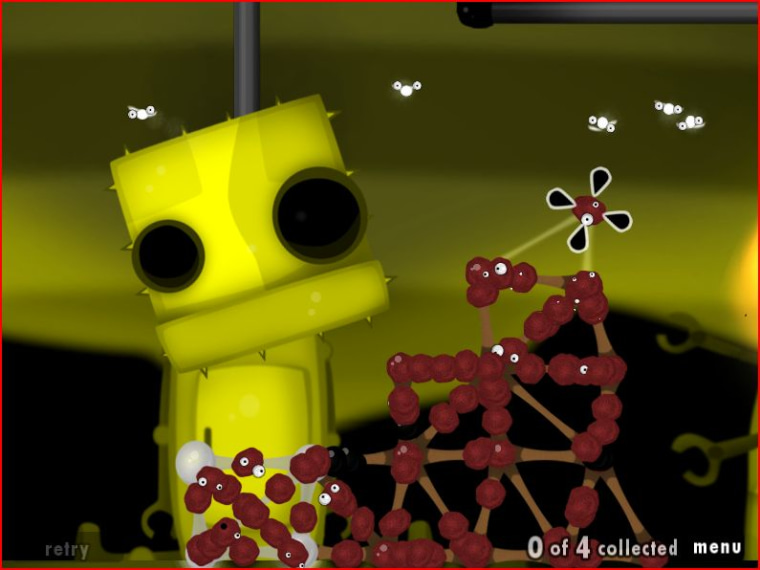When I last spoke to Kyle Gabler, the 27-year-old San Francisco game designer was up to his earlobes in debt, what with those school loans of his and the fact he’d up and quit his day job at a giant game corporation to go off and pursue his dream of making a video game he could call his very own.
How did he put it? Oh yes, “My net worth is horribly negative,” he said from the coffee shop he was calling his office at the time.
Gabler, along with his cohort Ron Carmel, have finally launched the game they’ve been working on for the past two years, a game that’s been bleeding their savings dry and driving them further into the crimson hues of debt.
It’s called “World of Goo,” and anyone who loves smart, surprising, fun, fun, fun games should be thanking this duo (collectively known as 2D Boy) for imperiling their financial futures for us … because this game is fantastic.
“World of Goo” is a bizarre, delightful and devoutly imaginative physics-based puzzle game. And like the indie hit “Braid,” which launched this summer, it’s an example of how small-time game developers fueled by nothing more than a unique vision and a willingness to take big risks are coming up with some the year’s most compelling, distinctive and buzzed-about games.
A gooey wonder
“When I played games as a kid there was this feeling of wonderment, like I could go anywhere and explore anything and it was like this new world you got to discover,” Gabler says. “One of the goals in making the game was to make something that had that same sort of magic and wonderment.”
And the world in “World of Goo” is a wondrous place – one that feels plucked from dreams haunted by Dr. Seuss and Tim Burton, a place where sticky gobs of goo spring to life and fantastical contraptions sprout from the landscape. It’s a game packed full of personality and original thinking and it has a mad sense of humor to boot.
The basic gameplay is this: You’re given these balls of goo that you must stick together to form various structures that help other balls of goo reach these mysterious pipes. Each level presents you with a minimum number of balls that must make it to these pipes, which then suck the balls up and whisk them away.

What that means is, you’ll construct great gooey towers that tilt and sway toward the sky and you’ll build bridges that wobble their way across vast crevasses. You’ll set goo balls to flight with balloons, and you’ll carefully place them so they interact with mechanisms that block their way.
And just when you think you have it all figured out, the game will throw you for a loop – present you with some new kind of goo ball or slap you with some astonishing new challenge that will set your brain whirring madly.
Throughout it all, there is this captivating-if-elusive story delivered primarily by the Sign Painter. This mischievous and unseen character guides players by leaving them wicked-funny and vaguely menacing messages. (For “Portal” fans, my fellow game reviewer Blake Snow calls the Sign Painter “the new GlaDOS.”)
It’s a tale in which a nefarious corporation lurks in the background, its motives unclear as the wide-eyed goo balls are swept up into its machinations. Sinister and silly at the same time, it’s also story that touches on some pretty heady stuff – corporate shenanigans, mindless consumerism, the disconnectedness of our constantly connected society.
“The story and ‘feeling’ of the game are inspired by that cold, insincere feeling you get when you are being marketed to by big smiling billboards and packaging and dancing laundry detergent boxes,” Gabler says.
Quit your job. Seriously.
It’s certainly a tale that speaks to 2D Boy’s resolutely independent spirit.
“World of Goo” was born out of the Experimental Gameplay Project, a rapid-prototyping challenge that Gabler helped found with a group of budding game designers. The plan: Shake as many unique video game ideas from their brains as quickly as possible. The rules: Each game had to be made by only one person and it had to be made in seven days or less.
“The only way to have a good idea is to have lots of ideas,” Gabler explains.
From that exercise, Gabler created “Tower of Goo” (in a mere four days) – and though it was only a prototype, it was a hit with the burgeoning indie games community. Gabler and Carmel, who met while working at Electronic Arts, decided to quit their day jobs and turn the goo-stacking prototype into a full game.
“We had no business plan at all when we started this,” Gabler says. “We just said we’re going to make a game we like and hopefully other people like it, too.”

Gabler handled the game design, art, story writing, and even created “World of Goo’s” superb soundtrack. Meanwhile, Carmel handled the programming and the business end of things. To keep everything on the cheap, they didn’t rent office space but worked out of coffee shops instead.
And Gabler is happy – if somewhat stunned – to report that their creative leap of faith has paid off not just for game fans … but for 2D Boy as well.
Those school loans? Yeah, they’re no longer a problem.
For a very reasonable $20, “World of Goo” can be downloaded straight to home computers from WorldOfGoo.com and through download services like Steam or Greenhouse. And for $15, it can be downloaded straight to the Wii through Nintendo’s WiiWare service. (It is the best WiiWare title to date.)
And though he won’t share specific sales figures, what Gabler will say is, “When we started this indie thing it was a risk. We didn’t know if we’d make money. We were working off of savings and if everybody hated our game we would be crushed financially and emotionally. But we can finally say that, two years after leaving our jobs, we are better off financially and emotionally than we would have been had we stayed at the same company where we were working.”
Not bad for a duo that’s put exactly zero marketing dollars behind their game.
Yes, word of mouth alone has carried the good word about “World of Goo,” which is charming the pants off game critics so much so that it’s currently ranked among the top games of the year.
Despite their success, Gabler and Carmel still operate out of coffee shops … and don’t have any desire to change that.
“We want to remain indie,” Gabler says. “We don’t want to be owned by any company. We don’t want to have any input coming in from any large publisher.”
In fact, Gabler is such a believer in the indie method of game making and the rewards it can reap, he has this piece of advice for others: "I fully recommend that anyone thinking about it, go ahead and quit your job and make your game.”
